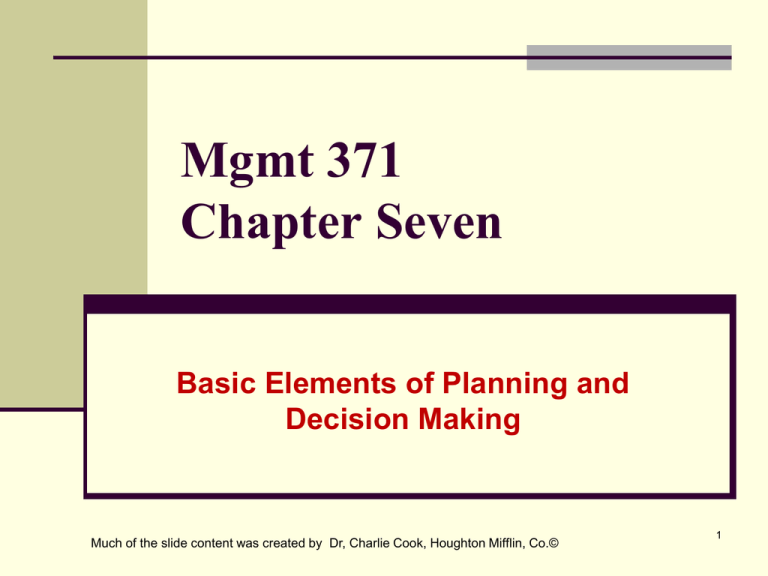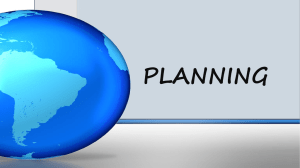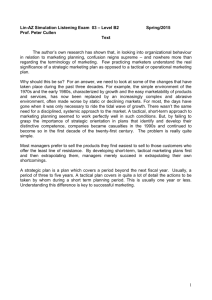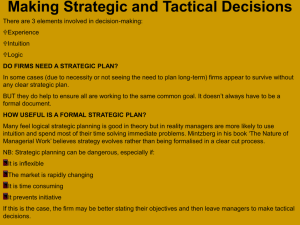Chapter Seven
advertisement

Mgmt 371 Chapter Seven Basic Elements of Planning and Decision Making Much of the slide content was created by Dr, Charlie Cook, Houghton Mifflin, Co.© 1 The Planning Process 2 Organizational Goals Purposes of Goals Provide guidance and a unified direction for people in the organization. Strongly affect on the quality of other aspects of planning. Serve as a source of motivation for employees. Provide a mechanism for evaluation and control of the organization. 3 Classifications of Goals By Level By Area By Time Frame 4 Kinds of Goals By Level Mission statement Strategic goals Tactical goals Operational goals . 5 Kinds of Goals By Area - Different functional areas of the organization. Marketing Finance HR Production By Time Frame Long-term Intermediate-term Short-term time frames Explicit time frames v. open-ended. 6 Kinds of Organizational Goals for a Regional FastFood Chain 7 Responsibilities of Setting Goals Who Sets Goals? All managers: managerial responsibility for goal setting should correspond to the manager’s level in the organization. Managing Multiple Goals Optimizing allows managers to balance and reconcile inconsistent or conflicting goals. Managers can choose to pursue one goal and exclude all others or to seek a mid-range goal. 8 Kinds of Organizational Plans Strategic Plans A general plan set by and for top management that outlines resource allocation, priorities, and action steps to achieve strategic goals. Tactical Plans A plan aimed at achieving the tactical goals set by and for middle management. Operational Plans Short-term focus plans that are set by and for lower-level managers. 9 Time Frames for Planning The Time Dimension of Planning - Planning must provide sufficient time to fulfill the managerial commitments involved. Long-range Plans Cover present and future strategic issues extending beyond five years in the future. Intermediate Plans Cover from 1 to 5 years and parallel tactical plans. Are the principal focus of organizational planning efforts. Short-range Plans Are action plans and reaction (contingency) plans that have a time frame of one year or less. 10 Responsibilities for Planning Planning Staff Gather information, coordinate planning activities, and take a broader view than individual managers. Planning Task Force Created when the organization wants a special circumstance addressed. Board of Directors Establishes corporate mission and strategy. May engage in strategic planning or may approve. Chief Executive Officer May serve as president or board chair; has a major role in planning and implementing the strategy. 11 Responsibilities for Planning (cont’d) Executive Committee Composed of top executives. Meets regularly with the CEO to review strategic plans. Line Management Have formal authority and responsibility for management of the organization. Help to formulate strategy by providing information. Responsible for executing the plans of top management. 12 Contingency Planning and Crisis Management Contingency Planning The determination of alternative courses of action to be taken if an intended plan is unexpectedly disrupted or rendered inappropriate. These plans help managers to cope with uncertainty and change. Anticipates problems and develops solutions for them before they happen. Crisis Management The set of procedures the organization uses in the event of a disaster or other unexpected calamity. Reaction 13 Contingency Planning 14 Developing Tactical Plans Recognize and understand the strategic plans and the tactical objectives. Specify relevant resource and time constraints. Recognize and identify human resource commitments. 15 Executing Tactical Plans Evaluate each course of action in light of the objective. Obtain and distribute information and resources. Monitor horizontal & vertical communication, and integration activities Monitor ongoing activities for goal achievement. 16 Types of Operational Plans Single Use Plans Designed to deal with a unique and nonrecurring situation. Post-Katrina recovery of MGM Grand They have a clear time frame for their usefulness (usually short-term) Often they are used once and then discarded. 17 Types of Operational Plans Standing Plans Ongoing guides for action dealing with recurring situations Marketing plans for global expansion, e.g. 18 Managing Goal-Setting and Planning Processes Barriers to Goal Setting and Planning As part of managing the goal-setting and planning process, managers must understand the barriers that can disrupt them. Managers must also know how to overcome them. 19 Barriers to Goal Setting and Planning Inappropriate goals Unrealistic Unethical Improper reward system (short-term results instead of long-term ones) Dynamic and complex environment Reluctance to establish goals (you will be accountable) Resistance to change Resource constraints 20 Reducing Barriers to Goal Setting and Planning Understanding the purpose of the goals and planning. Explain the consequences of doing nothing. Communication and participation (make your goals their goals — Roald Amundsen). Consistency, revision, and updating Effective reward system 21 The Formal Goal-setting Process 22 How Formal Goal Setting Contributes to Organizational Success Improved employee motivation Enhances communication Fosters more objective performance appraisals Focuses attention on appropriate goals and plans Helps identify managerial talent Provides a systematic management philosophy Facilitates control of the organization 23 Factors Contributing to the Failure of Formal Goal Setting Poor implementation of the goal setting process Lack of top-management support for goal setting Delegation of the goal-setting process to lower levels Overemphasis on quantitative goals Too much paperwork and record keeping Managerial resistance to goal setting 24







